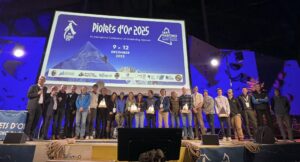What makes a climber choose one peak over another, especially in a sea of mountains like the Himalaya?
In the case of the top Slovenian team that recently opened the impressive ‘Slovenian Direct’ route up Chobutse’s West Face, it was pure aesthetic pleasure and the joy of climbing, Luka Strazar told ExplorersWeb this week.
Above all, Strazar, Nejc Marcic, Marko Prezejl, and Matija Volontar wanted to climb together. Where they went was secondary. But the location became clear when Marcic sent the others a photo of a potential peak, Chobutse.
“I instantly remembered the mountain,” Strazar recalled. “I was there in 2015, and the Northwest Face made an impression with its prominence and symmetry.”

Chobutse: a prominent peak in a sea of mountains. Photo: Luka Strazar
All was settled. The team traveled to Nepal’s Rolwaling Valley with only Chobutse in mind. They acclimatized on nearby slopes while studying the options on their chosen face.
The four Slovenians stayed together in Base Camp but split into two teams for the climb. “Nejc [Marcic] was sick the first week so he couldn’t do the acclimatization with the rest of us,” Strazar said. “During that time, I joined Marko and Matija.”

Strazar, left, and Marcic on the summit of Chobutse. Prezejl and Volontar tried a different route but eventually turned around. Photo: Luka Strazar
They climbed alpine style, said Strazar. “We made two bivies and on the third day, we reached the summit and descended back to BC,” he said. “We didn’t take the tent with us since the face is quite steep. In the end, that proved to be quite a good decision because we climbed lighter.”
Light and fast are always essential on highly technical faces. As the climbers previously mentioned, they were lucky to find good bivy spots.
Strong winds
Strazar also shared details about the route. “There were six steep pitches in the central part, where the climbing was rather slow,” he said. “The terrain was mixed and we already had problems with spindrift. Later, we saw that wind high up was really strong, hence the spindrift.”

One of the central “quite steep” pitches on Chobutse’s ‘Slovenian Direct’ route. Photo: Luka Strazar
“Not counting the spindrift and altitude, the climbing was fun and interesting,” the Slovenian concluded. “It’s nice to get the arms pumping now and then!”
This fall, there’s been increasing interest in smaller expeditions on new routes or lightweight ascents of 6,000m or 7,000m peaks. They compare favorably to a certain saturation around Manaslu or other highly commercialized peaks such as Ama Dablam.
For Strazar, commercial expeditions to 8,000’ers and climbs like Chobutse are simply impossible to compare.
“They are really two different worlds,” he said. “Sure, they happen close to each other geographically, but they are pretty far apart in terms of approach, ethics, and especially mindset.”

The ‘Slovenian Direct’ route up Chobutse.






